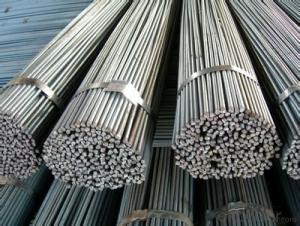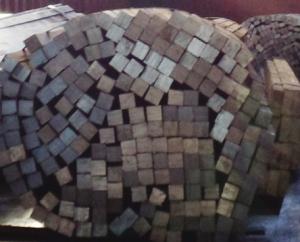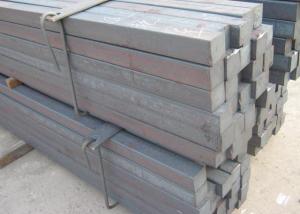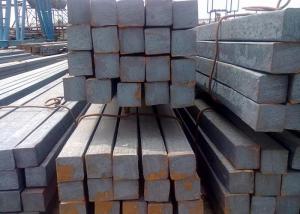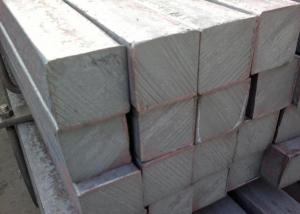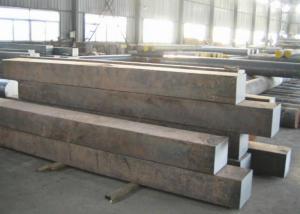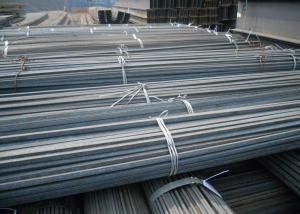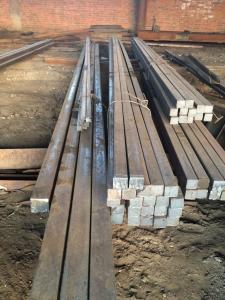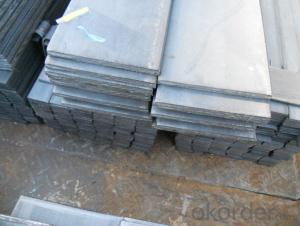Hot Rolled Round Steel Bars Q235
- Loading Port:
- Tianjin
- Payment Terms:
- TT OR LC
- Min Order Qty:
- -
- Supply Capability:
- 200000 m.t./month
OKorder Service Pledge
OKorder Financial Service
You Might Also Like
Specifications of Hot Rolled Round Bar
1. Grade: Q235, SS400, A36, S235JR
2. Diameter: 6mm—150mm
3. Length: As customer’s request, but we usually produce 6m, 9m and 12m
4. Steel Grade: Mild carbon steel
5. Characteristics: Has a good harden ability, high hardness, wear resistance, heat distortion, etc. So it can be used in the production of heavy duty and complex shape mold.
6. Main Markets: Mid East, Southeast Asia, Africa, Oceania, Eastern Asia, Central America and South America, etc.
Usage and Applications of Hot Rolled Round Bar
1. Hot rolled round bar of 6-25mm, or small round is mostly used for straight bundles supply, and used for steel, bolts and various mechanical parts. While the bigger round bar, or more than 25mm hot rolled bar, is mainly for the manufacture of mechanical parts or for seamless steel billet.
2. Besides, we can supply some especial material steel round bar that can be used for main shaft of steamer, hummer shank, with big section and supper force.
Packaging & Delivery of Hot Rolled Round Bar
Packaging Detail: All goods are packed in bundle with steel strips and shipped by break bulk vessel or container (depend on target market and different ports)
Delivery Detail: 45 days
Trade terms: FOB, CFR, CIF
MOQ: 25 tons per specification; we can negotiate the quantity if the specification is normal or we have stock of one specification.
Weight: Theprice invoicing on theoretical weight basis or actual weight basis depends on customer’s request.
Shipment: The shipment of bulk break or container is depends on customer’s request and the situation of the port of destination.
Documents given: Full set of original clean on board bill of lading; Original signed commercial invoice; Original packing list; Policy of insurance; Certificate of origin and what the target market needs.
Production Flow of Hot Rolled Round Bar
We use advanced equipments like Electric Arc Furnace, Ladle Furnace and Vacuum Degasser to produce our products.
The common processes are preheated forging quenching, dual refinement solution process, cooling quenching and isothermal quenching. We use heat treatment for dual refinement solution process. The main measures process is high temperature solution and refinement cycle. High temperature solution can improve the carbide morphology and particle size. The aim is to make the loop refinement ultrafine austenite grains.
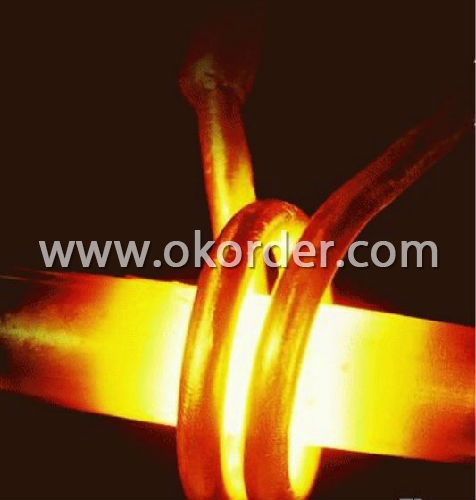
Quality Assurance of Hot Rolled Round Bar
1. We will strictly inspect our production that we sold according to the customer’s request.
2. Quality should be in conformity with the specification of the manufacturer. Quantity and packing conditions should be in conformity with the term in the contract.
3. Should the packing found damaged, the buyer has the right to claim to the seller.
- Q: Can a steel square be used for chair rail installation?
- Yes, a steel square can be used for chair rail installation.
- Q: Are there any safety considerations when using a steel square?
- Yes, there are several safety considerations when using a steel square. Firstly, it is important to handle the steel square with care, as it can have sharp edges and corners that can cause injuries if mishandled. It is advisable to wear protective gloves when using a steel square to avoid cuts or abrasions. Additionally, when using a steel square for measuring or marking purposes, it is essential to ensure that the square is properly aligned and positioned. Incorrect alignment can lead to inaccurate measurements or markings, which can result in errors in construction or other related tasks. Moreover, when using a steel square in conjunction with other tools or equipment, it is crucial to exercise caution and follow proper safety protocols. For example, if using a steel square with a saw or other cutting tools, it is important to maintain a safe distance between hands and the blade to prevent accidental injuries. Lastly, it is essential to store the steel square in a safe and organized manner when not in use. This includes properly securing it to avoid accidental falls or tripping hazards. It is also recommended to regularly inspect the steel square for any signs of damage or wear that may compromise its structural integrity and safety. Overall, by being mindful of these safety considerations, one can effectively and safely use a steel square in various applications.
- Q: Can a steel square be used for automotive repairs?
- Yes, a steel square can be used for automotive repairs. A steel square, also known as a framing square or carpenter's square, is a versatile tool that can be used in a variety of applications, including automotive repairs. It can be used to check and mark straight edges, ensure proper angles, measure distances, and create precise cuts. In automotive repairs, a steel square can be particularly useful for measuring and aligning components, checking for squareness, and verifying the accuracy of angles during the repair process. Whether it's for bodywork, frame straightening, or other automotive repairs, a steel square can provide a reliable and accurate reference tool, making it a valuable asset in any automotive repair toolkit.
- Q: Can a steel square be used for determining the correct depth of a dado cut?
- Yes, a steel square can be used for determining the correct depth of a dado cut. The square can be placed against the side of the material, allowing you to measure and mark the desired depth accurately before making the cut.
- Q: How do you use a steel square to find angles for compound miter cuts?
- To use a steel square to find angles for compound miter cuts, you need to follow these steps: 1. Begin by understanding the concept of compound miter cuts. These cuts involve two angles: the bevel angle, which determines the tilt of the saw blade, and the miter angle, which determines the angle at which the material is cut horizontally. 2. Set the bevel angle on your saw to the desired tilt. This angle is usually indicated on the bevel scale of the saw or can be calculated using a protractor. 3. Take your steel square and position it against the fence of the saw, ensuring that the long edge of the square is parallel to the fence. 4. Place your workpiece against the square and align it with the edge of the square. Make sure the workpiece is flush against the fence. 5. Adjust the miter angle on your saw until the corner of the square is aligned with the desired angle for your cut. The corner of the square represents the intersection of the bevel and miter angles. 6. Once the miter angle is set, lock it in place on your saw. 7. Double-check your setup by making a test cut on a scrap piece of material. Measure the resulting angle using a protractor or a digital angle finder to ensure accuracy. Remember, compound miter cuts can be complex, so it's crucial to carefully understand the specific angles required for your project and adjust your saw accordingly. Additionally, always prioritize safety by wearing appropriate protective gear and using caution when operating power tools.
- Q: Can a steel square be used for checking the levelness of floors?
- No, a steel square cannot be used for checking the levelness of floors. A steel square, also known as a carpenter's square, is primarily used for measuring and marking right angles in woodworking. It is not designed to accurately determine the levelness of surfaces. To check the levelness of floors, a tool such as a spirit level or laser level should be used. These tools are specifically designed for this purpose and provide accurate measurements of horizontal or vertical levelness.
- Q: What is the difference between a steel square and a framing square?
- A steel square and a framing square are both useful tools in carpentry and construction, but they have some key differences. A steel square, also known as a carpenter's square or a framing square, is a versatile measuring and marking tool. It is typically made of steel and consists of two arms, one longer and one shorter, joined at a right angle. The longer arm is called the blade, and the shorter arm is called the tongue. The steel square usually has a series of measurements and markings along its edges to aid in accurate measurements and layout. On the other hand, a framing square is a specific type of steel square that is primarily used in framing and layout work. It is also made of steel and features the same right-angle design as a standard steel square. However, a framing square has additional features that make it more suitable for framing tasks. It typically has a wider blade and tongue, allowing for more accurate and stable measurements and cuts. The wider blade is often graduated with measurements and markings specific to framing, such as rafter lengths, roof pitches, and stair layouts. In summary, while both a steel square and a framing square are made of steel and have a right-angle design, a framing square is a specialized type of steel square specifically designed for framing tasks. It has a wider blade and tongue and is typically graduated with measurements and markings specific to framing work.
- Q: What are some common measurements that can be taken with a steel square in plumbing rough-ins?
- The steel square, also referred to as a framing square or carpenter's square, proves to be a multifunctional instrument applicable in diverse stages of plumbing rough-ins. Several common measurements can be conducted using a steel square in plumbing rough-ins, including: 1. Right angles: The steel square boasts a 90-degree angle, which proves ideal for examining and marking right angles during plumbing installations. This proves critical in guaranteeing the precise alignment and squareness of pipes, fittings, and walls. 2. Parallel lines: By utilizing the elongated edge of the steel square, one can effortlessly trace parallel lines along walls or floors. This becomes particularly advantageous when aligning pipes and fixtures that necessitate installation in a straight line. 3. Angles for pipes and fittings: By positioning the steel square against a pipe or fitting, one can ascertain and mark the angle at which it should be cut or bent. This becomes vital in achieving accurate and precise connections between pipes. 4. Layout of stud walls: Throughout plumbing rough-ins, stud walls are frequently constructed to accommodate pipes and offer support for fixtures. The steel square can be utilized to lay out and mark the positions of studs, ensuring proper spacing and alignment for the plumbing system. 5. Pipe centerlines: Through employing the steel square's measurements, one can accurately indicate the centerlines of pipes on walls or floors. This becomes indispensable in guiding the pipe installation process and ensuring proper alignment and positioning. In general, the steel square proves to be an adaptable tool suitable for various measurements in plumbing rough-ins. Its capacity to provide precise right angles, parallel lines, pipe angles, stud wall layouts, and pipe centerlines renders it an invaluable tool for plumbers, guaranteeing the correct installation of plumbing systems.
- Q: Can a steel square be used for retaining wall layout and construction?
- Yes, a steel square can be used for retaining wall layout and construction. A steel square, also known as a framing square, is a versatile tool that can be used for a variety of carpentry and construction tasks. It is particularly useful for measuring and marking right angles, which is essential for laying out a retaining wall accurately. When constructing a retaining wall, it is crucial to ensure that all angles are properly measured and marked to ensure the wall is level and structurally sound. A steel square can be used to measure and mark right angles, which are necessary for laying out the base and corners of the wall. This ensures that the wall is built straight and in line with the desired layout. Additionally, a steel square can be used to check for squareness during the construction process. By placing the square against the corners and edges of the wall, you can verify that they are at perfect right angles. This helps to maintain the integrity and stability of the retaining wall. In summary, a steel square is a useful tool for retaining wall layout and construction as it enables accurate measurement and marking of right angles. It helps ensure that the wall is built straight, level, and structurally sound.
- Q: Can a steel square be used for framing walls?
- Yes, a steel square can be used for framing walls. Steel squares, also known as framing squares or carpenter squares, are versatile tools that can be used in various construction tasks, including framing walls. They are typically made of steel and have a 90-degree angle, making them suitable for measuring and marking right angles, laying out cuts, and checking the squareness of walls during framing.
Send your message to us
Hot Rolled Round Steel Bars Q235
- Loading Port:
- Tianjin
- Payment Terms:
- TT OR LC
- Min Order Qty:
- -
- Supply Capability:
- 200000 m.t./month
OKorder Service Pledge
OKorder Financial Service
Similar products
Hot products
Hot Searches
Related keywords
